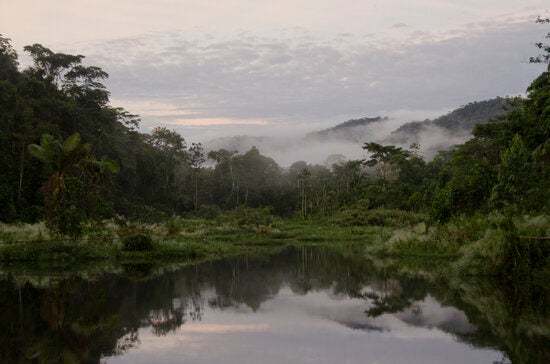Within the 10 minutes it takes to read this article it has been estimated that a section of forest the size of two hundred football pitches would have been destroyed. The Amazon is the most biodiverse section of tropical rainforest in the world with an estimated 390 billion individual trees, representing over half of Earths remaining rain forests. In the 450 years of European colonization in South America, an extremely small percentage of the Amazon was touched. During the past 40 years, 20 % of the Amazon has been demolished. This staggering percentage will only increase, and is a revealing picture of the destruction occurring. If this rate of deforestation continues, then forest health can only get worse and the damage to biodiversity more apparent.

Image courtesy of Frontier's Peru Amazon Rainforest Conservation project.
The Amazon rainforest is the largest gathering of trees on the planet, covering 5,500,000 square kilometers. The area is vast, spread across nine countries: the majority in Brazil (60%), followed by 13% in Peru 10% in Colombia and other small variants in Venezuela, Ecuador, Bolivia, Guyana, Suriname and French Guiana.
The Amazon creates roughly half of its own rain fall from self-producing moisture; if there is a continuous increase in deforestation then the affects will not only have consequences on the rainforest's ecosystems, but also on the worlds weather. If deforestation continues almost half of the world's animal and plant species' existence will be in question. The Rainforest Action Network have said that from 2000 to 2006 a land mass of 93,000 square miles was destroyed, equivalent to the size of the UK. This overwhelming rate of deforestation means that the possibilities the forest holds for curing diseases and creating medicines also die with the forest.
Beneath all the wild biodiversity there are hundreds of tribesmen that have lived off the land for hundreds of years, following in the footsteps of their ancestors. There are around 400 tribes living in the Amazon, each speaking with a different tongue but facing the same difficulties when it comes to land. Land for tribes equates to life. They rely on their land to live, hunt, and rest, so their situation is problematic as deforestation acts as destruction of this land. Tribes of Indians living in Brazil have no land ownership rights and, like many tribes, are facing annihilation and are dying trying to save their home from corporate invasiveness.
What does deforestation mean for them? Tribesmen are endangered peoples who are under threat just like their habitat; organizations like Survival International are dedicated to helping them. Ninety tribes are thought to have completely disappeared during the 20th century, with many being wiped out due to foreign invasion bringing diseases the tribes were not accustomed to.
Carbon dioxide is produced naturally and through human sources. For years, we have been pumping CO2 into the atmosphere by burning fossil fuels. The Amazon has, in return, reduced this carbon imprint because trees naturally absorb CO2 in exchange for oxygen. The protection of the rain forest then, is extremely important to ensure the maintenance of the already overpopulated CO2 levels in the atmosphere. This is only exaggerated by the fact that when trees are cut down and burned, there is an added effect through the release of CO2.
Deforestation of the Amazon is a very serious problem that we need to face as an international community in order to overcome it. Raising awareness for the importance of preserving biodiversity on both a local and global scale is the starting point. It is then a case of looking globally for alternatives of deforestation, more sustainable methods of deforestation, and projects that involve reforestation. The rainforest is a source of life, not only for those that live directly from its land, but for the whole world which benefits from its influences on the climate and reducing of carbon dioxide in the atmosphere. The Amazon is still a mystery to us, proven by the fact we are still, in 2013, discovering new plant and animal species in the tropical wonderland. It is truly a magical place and by making everyone aware of the dangers of its destruction, then as a collective we can try to do something about it.
Author Ed Hawes is the Online Journalism Intern for Frontier, an international non-profit volunteering NGO that runs 320 conservation, community, and adventure projects in 57 countries across the globe. Find out more about volunteering opportunities in Amazon conservation. You can read more articles on Frontier's Gap Year Blog and get the latest project and volunteering news from the Frontier Official Facebook page.
Follow Ed on Twitter: www.twitter.com/ed_hawes
